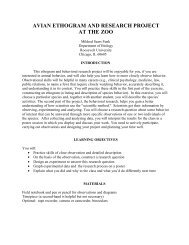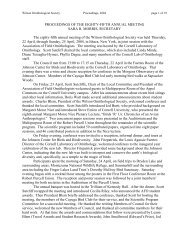Available now - Wilson Ornithological Society
Available now - Wilson Ornithological Society
Available now - Wilson Ornithological Society
You also want an ePaper? Increase the reach of your titles
YUMPU automatically turns print PDFs into web optimized ePapers that Google loves.
WOS 2010 ~ ABSTRACTS p. 32<br />
all 149 species [Prob (Ha|data)= 0.98]. On average, all species distributions have shifted approximately 58 km to the<br />
north. Separating north and south movements we found the majority of species (n = 107) show a northern shift of<br />
approximately 92 km and the remaining species (n = 42) have shifted south on average 40 km. The initial results of<br />
our study are similar to recent studies and provide more support for climate driven range shifts among birds. Further<br />
work will evaluate elevation changes, boundary changes and overall changes in status of breeding species in<br />
Ontario.<br />
P18 S The effectiveness of constant effort mist-netting in estimating abundance and reproductive success of a Wood<br />
Thrush population. Laura M. Niczyporowicz and Todd J. Underwood, Dept. Biology, Kutztown Univ., and Roland<br />
R. Roth, Dept. Entomology and Wildlife Ecology, Univ. Delaware, Newark, DE 19716<br />
Despite the widespread use of Constant Effort Mist-Netting (CEM) to monitor population demographics of<br />
landbirds, relatively little is k<strong>now</strong>n about the validity of CEM estimates for various species of birds. In this study,<br />
we determined whether CEM was an effective way to gauge the abundance and reproductive success of a Wood<br />
Thrush population. We used linear regression to compare estimates of Wood Thrush demographic variables<br />
generated by CEM to actual demographic values measured by intense nest searching and monitoring in the same<br />
area over a period of six years. The demographic variables compared were: number of males, number of females,<br />
number of HY (Hatch Year) birds, number of AHY (After Hatch Year) birds, and the ratio of HY to AHY birds. All<br />
CEM estimates were standardized as the number of captures per 100 net hours. We found that only the CEM<br />
estimates for HY birds (r2 = 0.85, P < 0.01) and the ratio of HYs to AHYs (r2 = 0.68, P < 0.05) were significantly<br />
related to actual values. CEM estimates of the three adult abundance variables were not significantly related to<br />
actual values. In conclusion, constant effort mist-netting may only be useful in estimating Wood Thrush<br />
demographic variables involving hatch year birds.<br />
P19 Evaluation of breeding habitat quality for a population in decline: the Canada Warbler in northeastern Vermont.<br />
Jameson F. Chace, Dept. Biology and Biomedical Science, Salve Regina Univ., Newport, RI 02840, and Steven D.<br />
Faccio, Vermont Center for Ecostudies, Norwich, VT 05055<br />
Canada Warbler (<strong>Wilson</strong>ia canadensis) populations have been in a 40-year decline and yet little is k<strong>now</strong>n about its<br />
population ecology. We have studied a population of Canada Warblers in the Nulhegan Basin of the Silvio O. Conte<br />
National Fish and Wildlife Refuge in northeastern Vermont since 2001. During 2002-2006 age structure ranged<br />
from 5.6:1 to 1.5:1 of After Second Year (ASY) to Second Year (SY) breeding males, and 30% ASY and 15% SY<br />
territorial males returned to the population each year. We measured the breeding habitat characteristics of 31<br />
territories (21 paired and 10 unpaired with females) and 20 nonuse points near those territories in the same habitat<br />
type at three locations. Canada Warbler male territories had a greater density of large (diameter > 2.5 cm) shrub and<br />
sapling stems and a greater percent ground cover of moss than the unoccupied "nonuse" points. During focal periods<br />
of observations (n=737), males sang significantly higher in vegetation than when they exclusively foraged. Density<br />
of understory stems was found highly correlated with prey abundance. Pairing success, however, was not related to<br />
any of the 25 vegetative characteristics measured on male territories. While pairing success (50%) and return rates<br />
(25%) in northeastern Vermont are relatively lower than those found among other populations of migratory<br />
warblers, population declines stemming from issues on nonbreeding grounds or during migration are probably more<br />
important factors in the population decline than are issues related breeding site quality in northeastern Vermont.<br />
P20 S The effect of Wood Thrush hosts on the survival of Brown-headed Cowbird eggs and nestlings. Ashley N.<br />
Rathman and William P. Brown, Dept. Biology, Kutztown Univ., Kutztown, PA 19530, and Roland R. Roth, Dept.<br />
Entomology and Wildlife Ecology, Univ. Delaware, Newark, DE 19716<br />
Although parasitic Brown-headed Cowbirds (Molothrus ater) have a detrimental effect on a wide range of hosts,<br />
cowbird fledging rates differ substantially among those hosts. The purpose of this study was to explore the effect of<br />
Wood Thrush (Hylocichla mustelina) hosts on cowbird survival through each nest stage (egg laying to incubation,<br />
incubation to hatching, hatching to fledging) as well as the overall survival rate from egg laying through fledging.<br />
Based on published observations, cowbird fledging success among other forest species hosts also was compared to<br />
our results. Reproductive data of individually marked Wood Thrushes, including brood parasitism data, were<br />
collected in Newark, Delaware, from 1975-2006. These data were used to construct a life table for both cowbirds<br />
and Wood Thrushes from egg laying through fledging. Chi-squared tests were used to determine the difference in<br />
survival of nest contents between Wood Thrushes and cowbirds. Both cowbirds and Wood Thrushes survived better<br />
during the incubation stage than during the laying and nestling stages. There was no difference in survival of<br />
cowbird and Wood Thrush eggs from laying to incubation. Wood Thrushes survived better than cowbirds in the<br />
incubation and nestling stages. Among a variety of forest-dwelling hosts, the success of cowbirds from egg laying<br />
through fledging ranged from 0% (House Finches, Carpodacus mexicanus) to 68.5% (Red-eyed Vireo, Vireo<br />
olivaceus); 21% of cowbirds in our study survived from laying through fledging. We suggest this wide range of<br />
cowbird success among hosts may be due to host diet or differential mass among host species.





